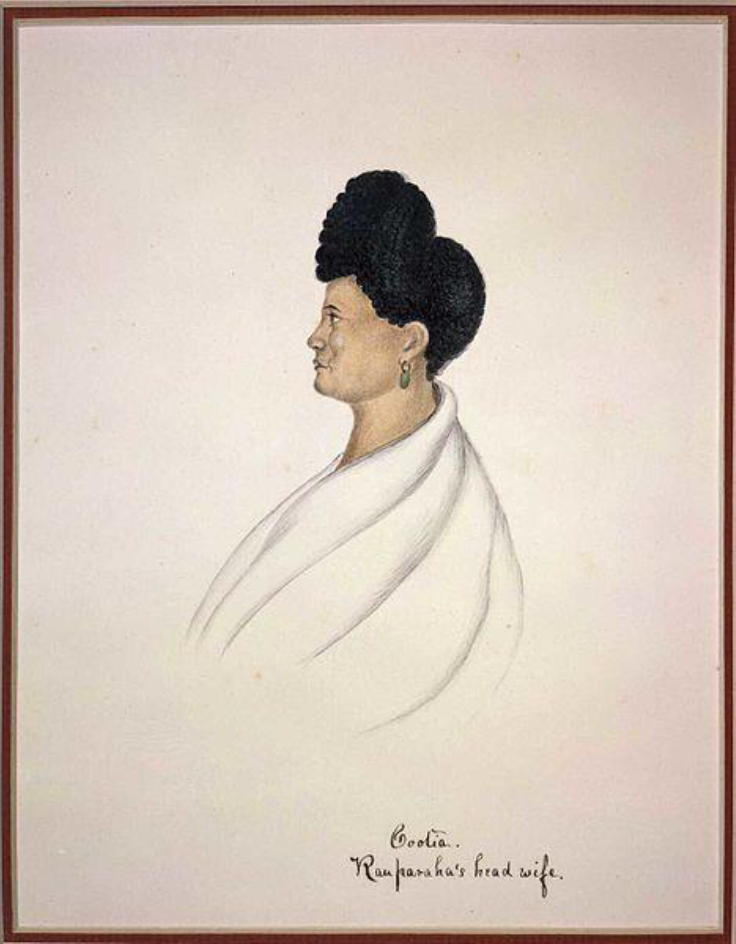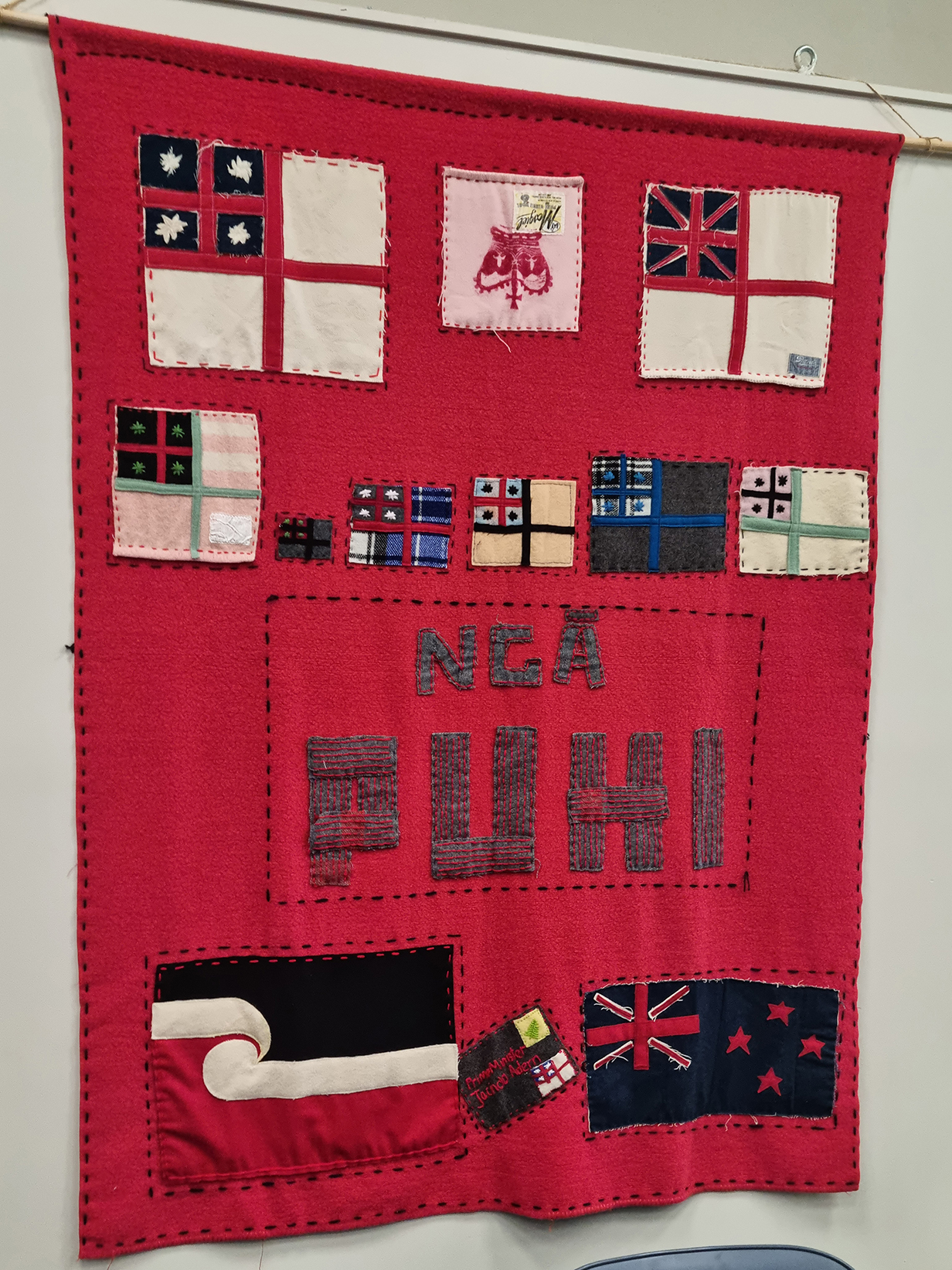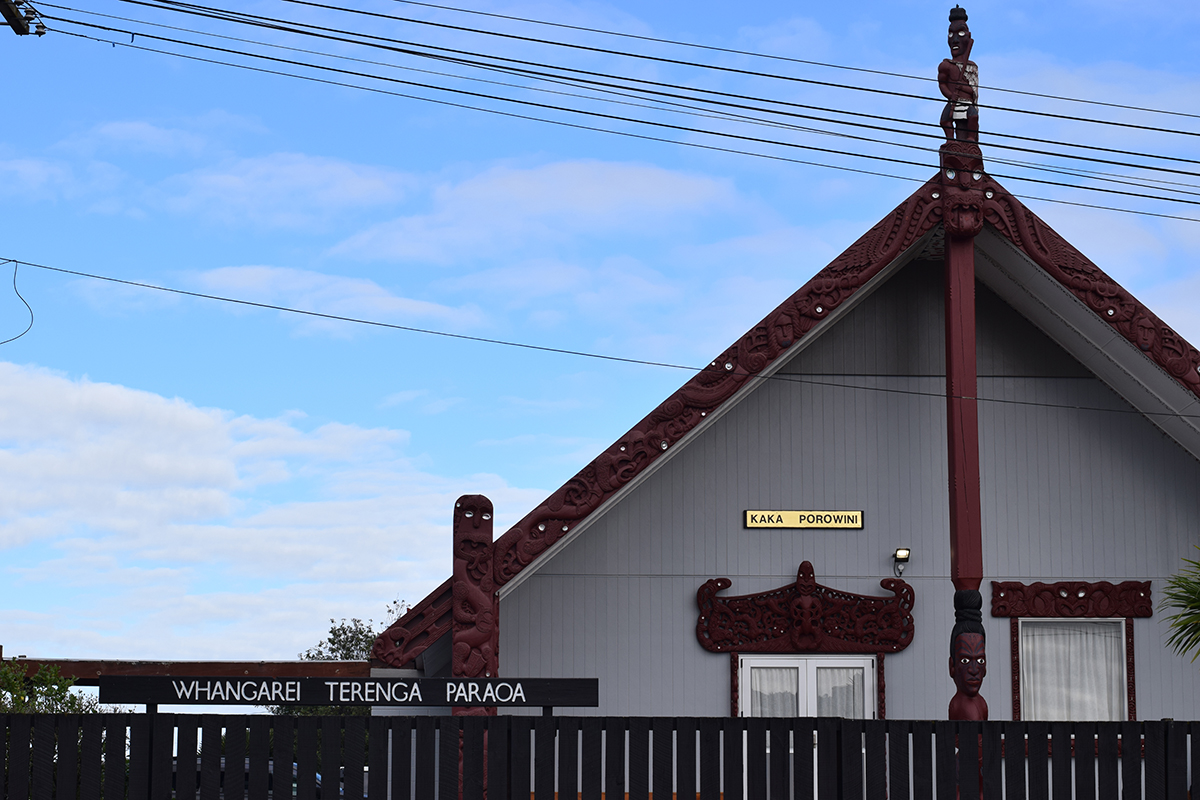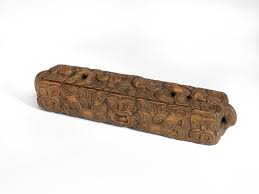Roles on the marae / Mahi-ā-te-pā
Witnesses identified the marae as a space where wāhine and tāne roles were often different but complimentary, and thus balance was retained. However, witnesses presented a variety of perspectives over whether wāhine had speaking rights on the paepae, or whether their restriction from this role is an impact of colonisation. Many witnesses emphasised the mana and importance of karanga, which they said can only be performed by wāhine. They described karanga as functioning to welcome, protect, keep peace, and discern the intentions of the manuhiri.
Key witnesses who gave evidence
Aorangi Kawiti (doc A24(a)) described the balance between ‘different and intertwined’ roles of wāhine and tāne, particularly shown by the role of wāhine as kaikaranga. Ms Kawiti said the role of kairanga is ‘to perceive, protect, welcome and repel manuhiri and whānau intentions, actions and progress into and within our traditional and contemporary territories. Wahine are the litmus, receptor, analyser and maintainer of peace, productivity and life. Without wahine Māori, hui and events of great and small import are unable to begin with the properly created balance of life’. She said that ‘karanga, as with all creative korero / communication, can be welcoming, alarming, alerting the whānau, hapū and iwi of impending risk of encroachment, attack, danger or ahua of any kind. Karanga can also be repelling in their nature, volume, expression and implementation. Kai karanga have a similar role to scouts, in terms of the ability and capacity of wahine Māori to sense with all senses – taha wairua, taha tinana, taha hinengaro and taha whānau the approach and intent of others to their kainga’. Ms Kawiti said kuia often lead kaikaranga, as ‘their senses are honed by years of experience, practice, understanding and knowledge. Kuia are often, though not always, beyond the childbearing stage of their life, therefore potentially more readily available for this key role and possibly more capable in fulfilling this crucial role to capacity. This is not always the case, so should always be considered on merit of the people and situation’.
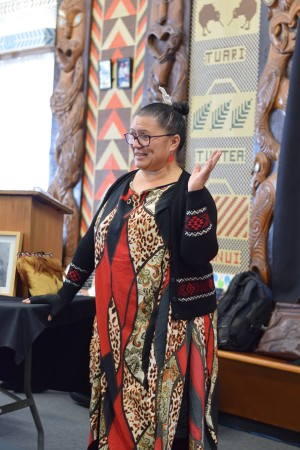
Aorangi Kawiti giving evidence at Terenga Parāoa Marae, Whangārei
Ipu Tito-Absolum (doc A70) is a Te Mahurehure ki Hokanga wāhine who gave evidence about wāhine roles on marae during tangihanga. She said that kuia played the role of tupoupou who ‘holds the responsibility and mana to provide protection for the Cosmic Space so that the spirits of our dead are given the rites of passage on their journey to Te Au o Te Reinga (the underworld abode) and Nga Rangi Tuhaha (upper-world abode)’ (p 6). She does so by keeping vigil beside the tūpāpaku, not taking food and drink, and keeping watch, and undertaking karanga to ‘arouse the emotions of visiting groups and raises the wailing pitch to assist the wairua on the Ara Wairua’. She also described ‘Te Ururangi’ which is the wailing undertaken by wāhine specifically in a tangihanga setting to open the space spiritually for the manuhiri.
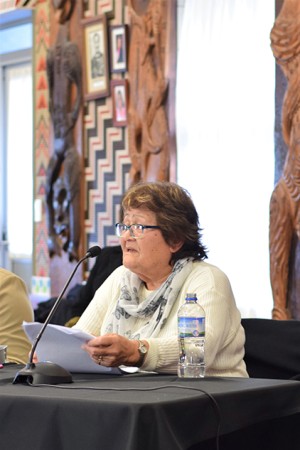
Ipu Tito-Absolum giving evidence at Terenga Parāoa Marae, Whangārei
Whakataukī
- “‘Ma te tangi o te wahine ka uru mai koe ki Te Ao Marama, ma te tangi o te wahine ka wehe atu ki te po.’ Upon the cry of a woman you enter into this world, and upon the cry of a woman you will leave. The tangi of a woman holds specific relevance in the rituals of the dead, in that they assist the wairua to detach from the body and begin its journey to Rarohenga.” (Tina Ngata, doc A88, p 9)(external link)
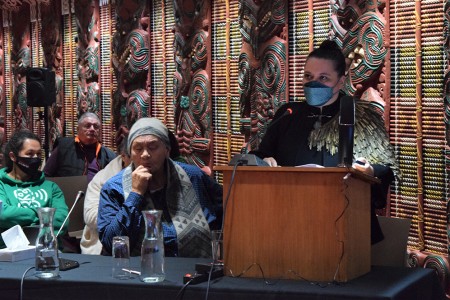
Tina Ngata giving evidence at Te Mānuka Tūtahi Marae, Whakatāne, pictured with Mereana Pitman (left)
What witnesses said
- “[T]hough oratory is thought of as the domain of men in many tribes, across all the tribes the first voice heard at the hui is that of a woman, through the kāranga, the call of welcome, from the tangata whenua to the manuhiri.” (Ella Henry, doc A63, pp 13-14)(external link)
- “On a marae, it is the men who whaikōrero on the paepae; whereas the wāhine karanga. The tane and wāhine do not act independently. They must work together.” (Materangatira Porter, doc A16(a), p 5)(external link)
- “Another area where males and females had designated ‘roles’ is in the matter of pōwhiri. Women will perform the karanga, while men carried out the mihi. I note here that for those women who are experienced at karanga, their call is as much a ‘speech’ as is the mihi of the men. While some rohe will expect the women to lead a waiata following the mihi, in other rohe, the male kai kōrero prefers to begin his own waiata. Here, again, it is worth noting that the waiata is in essence an extension of the kōrero delivered in the mihi by the kaikōrero, irrespective of whether they are male or female.” (Patricia Tauroa, doc A60, pp 11-12)(external link)
- “Wāhine Māori in Ngāti Pakahi spoke on the paepae. They were fluent, but blunt. They got down to business. Wāhine were more efficient as they did not exhibit the flamboyance and powerplays of the men. Wāhine did not partake in the men’s nonsense of bollocks swinging, especially in Ngāti Uru. The men shuddered when wāhine spoke on the paepae. The wāhine speakers got to the point.” (Violet Walker, doc A66, pp 8-9)(external link)
- “The women of Waitaha did the whaikōrero. They speak, not their men – the women did. Generations later, when nKāti Māmoe came to Aotearoa, the kawa started to change. The women got the whakapapa, and the men got the korero, the men took on the speaking. Then when nKaitahu came, the men took the whakapapa and the korero.” (Ema Roriana Weepu, doc A136, p 7)(external link)
- “Our wāhine were matriarchs, and they had an equivalent role to tāne. This only changed on the marae. On the marae, the tāne had their roles to get up and korero, and the wāhine waiata.” (Paihere Clarke, doc A141, p 3)(external link)
- “Māori women are the first voice (the Kaikaranga) to be heard on the marae. It is a role exclusive to Māori women. As a Kaikaranga, it is essential that there be a connection between the spiritual and physical realms. The kairanga is about our existence and our ties to past, current, and our future generations. It concerns how we relate to the environment and whenua.” (Hinemoa Ranginui-Mansell, doc A129, p 3)(external link)
- “I believe the karanga is one of the most potent expressions of mana wāhine. Through the karanga, the marae ātea is made tapu through the woman’s voice and words … The karanga is just as important, and is complimentary to, the role of men with whaikōrero. The karanga is an exchange between tangata whenua and manuhiri to ascertain the nature of the visit and the visitors, thus providing the basis for the whaikōrero. In some cases, women can express their opinions or refer to topical matters through the karanga.” (Kayreen Tapuke, doc A94, pp 5-6)(external link)
- “Before the influences of pakeha, through their missionaries and settlers, our wahine had equal roles on the marae. Wahine could speak on the marae. The relationship between men and women was one of balance.” (Titewhai Harawira, doc A68, p 3)(external link)
- “In pre-colonial Māori society there was no sense of male superiority. Rather, the roles of tāne and wāhine were seen as complementary. A tāne speaking on the marae expresses the tihei mauri ora homai te wai ora ki ahau ‘give me the life-giving life force,’ referencing the sperm which enables the capacity for wāhine to ensure the survival of the people. Having tāne sit at the front on the marae was not to demonstrate superiority, but for protection of te whare tangata. In our Mataatua area, it is the duty of the tāne to protect the wāhine from the darts of verbal cursing which could eradicate the whakapapa of that whānau / hapū.” (Maanu Paul, doc A51, p 3)(external link)
- “The question of whether women should speak on the marae today. There is no question. I speak everywhere I go. No one ever challenges my right to speak. In Ngāti Hine, men do the whakatau at the marae, but other than that, women speak. The reinstatement of women is now taking a lot of unbundling, and we are having to have a conversation about our relationship with Māori men.” (Moe Milne, doc A62, p 27)(external link)
- “There is not and never has been a gendered approach to how we approach speaking at hui. The mana to speak comes not from gender, but from whakapapa, and ahi kaa combined with knowledge and ability on a given kaupapa. If your whakapapa line gives you mana and you have maintained your ahi kaa to our whenua and to our rohe, you have the mana to speak and to make decisions at our hui. An important component of this tikanga though, is you as a person must be engaged participating and contributing to upholding the mauri of the hapū.” (Tracy Hillier, doc A92, p 16)(external link)
- “The mahi o te tane is to protect wahine … When the men spoke on the paepae they stood out in front of the people, and in standing there, there is a potential for them to be attacked first. In this way, Tūhoe men protected the wahine and this is another reason Tūhoe wahine do not whaikōrero.” (Materangatira Lily Porter, doc A16(a), p 3)(external link)
- “Ko te pae o waho ka tū te tane ki te whai kōrero. Ka tū te wahine, te reo tuatahi ki te karanga. Nā mena kei te titiro atu ko wai te tuatahi? Ko te wahine. Ka titiro tātou kei a wai ngā kōrero i te marae? Kei a rāua tahi i te mea me mahi tahi rāua i tēnei wā ki a kitea mai kei te tau te hapū, kei te ora te hapū me te marae.” (Hera Black-Te Rangi and Mareta Taute, doc A116, pp 14-15)(external link)
- “Mai rāno e āhei ana ngā wāhine ki te kōrero i runga i ngā marae. E āhei ana ngā wahine o Te Whakatōhea ki te kōrero i runga i ngā Marae o Te Whakatōhea. Ko ngā tauira ko Mihi Kotukutuku, ko Whaia McClutchie hoki te tokorua i tū kaha, i tū māia ki runga i ngā marae maha ki te whaikōrero.” (Sharon Campbell and Dr Mania Campbell, doc A39, p 11)(external link)
- “Since the beginning of time women possess the mana to stand and speak on marae. In particular the women of Te Whakatōhea have speaking rights on the marae of Te Whakatōhea. Some examples of this important tradition are Mihi Kotukutuku and Whaia McClutchie, these women stood well and without fear on different marae to deliver speeches.” (Sharon Campbell and Dr Mania Campbell, doc A39(a), p 11)(external link)
- “He aha ngā tauira e kitea te mana wahine i ngā whakapapa a Māori nei? ... He wahine mohio ki te mihi maioha ki te tangatan karanga, waiata tautoko, whakahaere nga Kaupapa a mua a, muri me te rahi whāngai te tangata me nga mokopuna. He wāhine tikanga.” (Hera Black-Te Rangi and Mareta Taute, doc A116, p 16)(external link)
